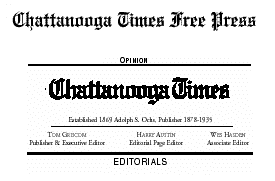Chattanooga Times Editorial
December 2, 2004
Board plan kills TVA conflict-of-interest ban
TVA's core trust issue |
 |
As the latest real estate proposal near Nickajack Dam illustrates, TVA remains subject to periodic offers from business people seeking to purchase and develop prime pieces of the agency's -- that is to say, the public's -- riverfront land. TVA' s board members owe their ratepayers, and also the families from whom they originally took that land, careful review of all such offers. Still, their guiding standard should be their long-term stewardship responsibilities for the agency's public properties -- and not a profit, either for TVA, or developers, or tax-hungry local governments. If TVA holds to that philosophy, it will reject this offer, as it has most others. Enterprises, a venture of Chattanooga developer John "Thunder" Thornton, seeks to purchase and develop 637 acres in the Shellmound/Little Cedar Mountain area adjacent to Nickajack Dam. TVA rejected a similar offer in 1999. It should do the same with this one.
Mr. Thornton proposes to build lakefront homes, an expanded marina and a golf course on the land. He also proposes to give to TVA some 832 acres of land, including Cedar Mountain and Burns Island, in addition to a payment for the lakefront land he seeks. His firm's president, Brandon Born, says the land the company would swap contains significant wildlife, habitat and archaeological resources comparable in those respects to the land the company seeks to buy.
That's a relative judgment, to be sure. The lakefront land, for TVA constituents as for Mr. Thornton, clearly is more valuable for both because of its lake access and views. Its archaeological and habitat values are already known. The Little Cedar Mountain riverfront property also already has a constituency of hunters, land preservationists, environmentalists and Native American advocates who want to protect its known archaeological and habitat resources. Their advocacy helped persuade TVA's board members in 1999 to preserve the land for public enjoyment. The logic of that decision again should prevail.
One of the core issues in such cases is how TVA should tilt in its interpretation of its basic charter functions for both resource protection and economic development. In this case, the former takes priority. TVA has a deep obligation, though one it occasionally and egregiously has violated, to preserve for public use the land it has taken from individual families by eminent domain since its founding in 1933 to build the Tennessee River reservoir system. Its economic development responsibilities flow mainly from other aspects of its operations, such as electricity and industrial development services.
In creating a manageable, navigable river and flood storage system, TVA seized vast amounts of prime river-bottom and farm land from legions of families across the Tennessee Valley. If any of that land now may be released, fairness would dictate that it would go to the families, or their heirs, who once owned the land and who, in many cases, vehemently opposed the seizures as excessive. Nickajack Dam, for example, was not built until 1967, and much of the land taken for the dam remains above water and unused for flood storage. There undoubtedly are families and heirs in Marion County who would now object to the sale of their former land to a for-profit developer for an upscale riverfront development over, say, preservation for public use or return of the land to the families who owned it.
This page has long supported the fundamental charter trust held by TVA to shepherd its public lands -- lands seized in the name of a greater public good -- for enduring public use. When TVA fails in that and other benchmark issues of public trust, it erodes its foundation as a public utility. TVA cannot afford that.
|